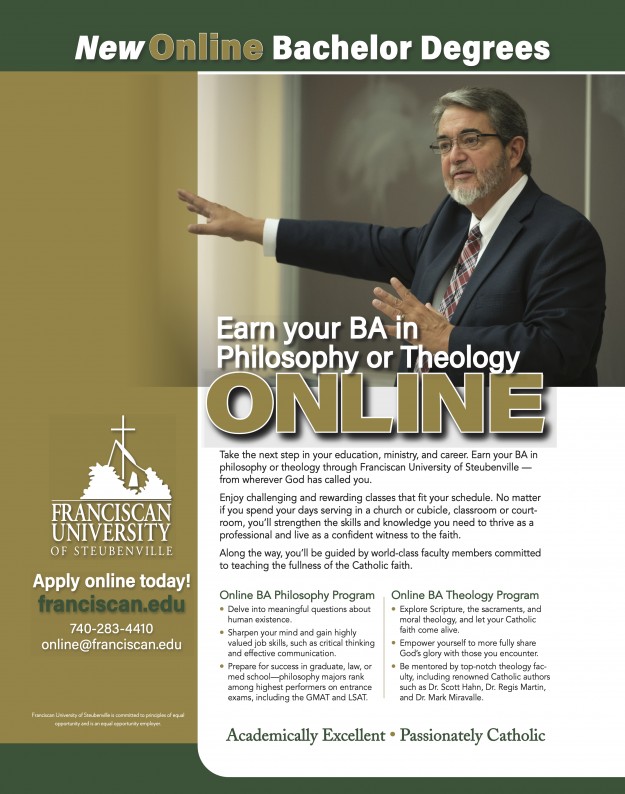Editor's Reflections: Kerygmatic Catechesis and the New Directory
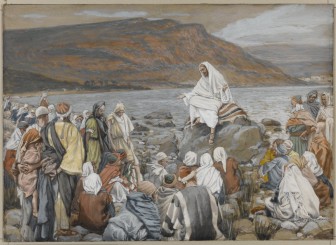 The much-anticipated Directory for Catechesis is finally here! So many of us involved in the work of catechetical renewal have eagerly awaited its publication.
The much-anticipated Directory for Catechesis is finally here! So many of us involved in the work of catechetical renewal have eagerly awaited its publication.
AD: Announcing Summer 2021 Steubenville Adult Conferences
To sign up for your preferred conference go to SteubenvilleConferences.com or call 740-283-6315.
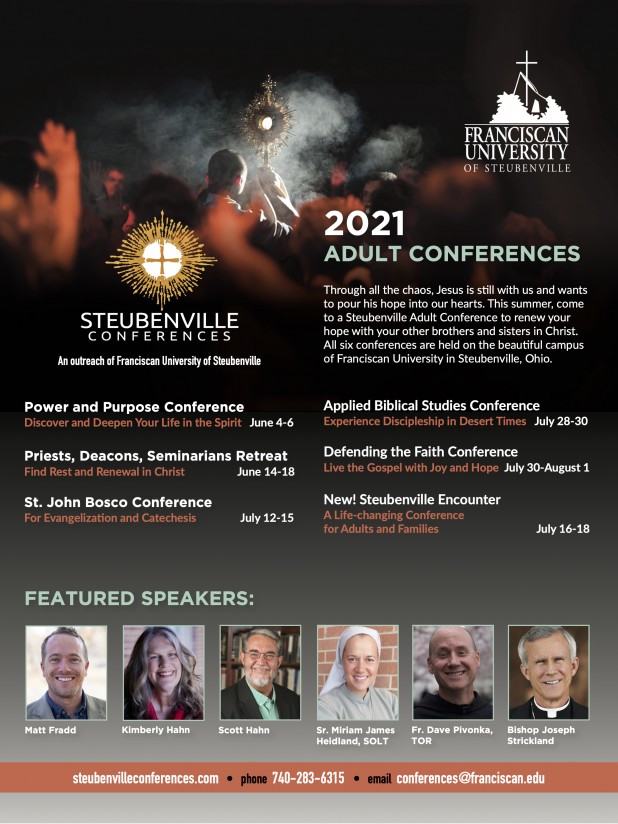
AD: Online Bachelor's Degree Programs in Theology & Philosophy
Apply online today at online.franciscan.edu. Or call 740-283-4410.
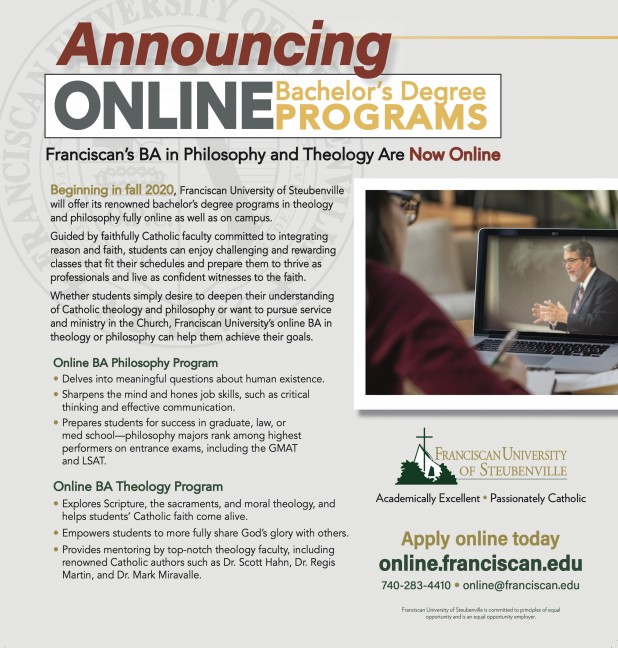
AD: New Book! An Evangelizing Catechesis, Teaching from Your Encounter with Christ
To order this book from Our Sunday Visitor click here. Or call (800) 348-2440.
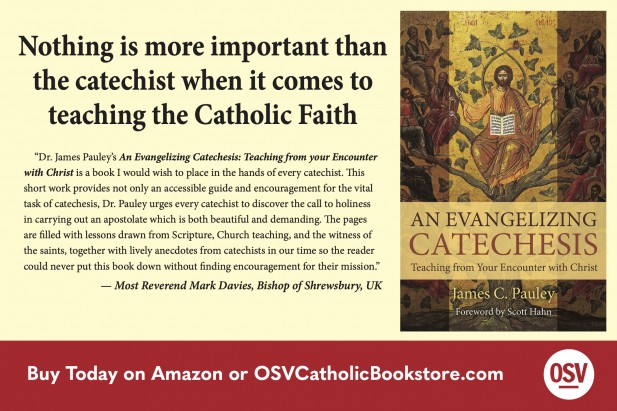
This is a paid advertisement in the October-December 2020 issue.
Barbara Morgan: Inspiring Us with Maternal Hope
Few people impact us on such a deep level that it changes our life journey. For me, that influence happened in 1994. In August of that year, Barbara Morgan began the catechetics program at Franciscan University of Steubenville. I had the great blessing of being there when it started. She became a spiritual mother to me and infused in me a deep sense of purpose. In this article, I would like to share a few ways in which she did that with me.
The First Class
Barbara’s significance in my life was unparalleled, and I knew it would be profound as soon as I encountered her. At that first class, in the course entitled “Content and Curriculum,” I sat in the front, which is usually not the case for me (give me the back row, please). Since I showed up to the MA program with almost six years of parish youth ministry experience, I wanted to pay attention, since this course would be geared directly to pastoral situations. Little did I know what I was in for. As much as I loved the study of theology in all its disciplines, when Barbara began to teach catechetics, I was moved at a far greater level than any subject I had studied before. Through her, God revealed my vocation and identity to me and, as a result, I could never be the same person.
After her first class, I could not contain myself. I followed her to her office and had to tell her my plans for a teen Confirmation resource. I’m sure I sounded like a babbling fool. What was happening was not about my ideas regarding Confirmation; in a real way all my grandiose plans and projects were secondary. The underlying reason I had to seek her out was because I had had an unprecedented encounter with the Lord. I was reacting with unabated joy to a calling and could not contain myself.
And that was just the first class.
La catequesis en cuarentena
¿Cómo se hace catequesis durante una pandemia?
Varios meses de separación forzosa de su grupo de RICA o su clase de Primera Comunión no es una contingencia para la cual es probable que algún catequista haya planeado. Sin embargo, aun cuando la vida ordinaria cambia más allá de toda familiaridad, el llamado que hace Cristo a Sus fieles a profundizar nuestra relación con Él ha permanecido constante – y también ha sido constante la necesidad de catequesis que hace eco de aquel llamado divino en Su Iglesia.
La sombría realidad de la cuarentena con su encierre ha incitado una respuesta inmediata e ingeniosa de parte de los catequistas. En la diócesis de Portsmouth, Reino Unido, esta respuesta ha adquirido varios formatos. Examinar cómo los catequistas de la diócesis han respondido a la crisis nos proporciona no solamente amplios ejemplos de maneras en las que la catequesis puede adaptarse a una situación de encierre o de cuarentena - a la cual la respuesta internacional al COVID-19 quizás no sea la última – sino que también destaca las dificultades y los retos que presenta una tal “catequesis de encierre” y lo que revela acerca de la práctica de la catequesis más ampliamente.
La catequesis en el Reino Unido
El encierre comenzó en el Reino Unido el día 23 de marzo del 2020, al clausurar los negocios, los establecimientos de servicios, y los lugares del culto, y con la prohibición de viajes no esenciales. En ese entonces, los catequistas del RICA se estaban preparando para acoger en la Iglesia a sus catecúmenos y candidatos en la próxima Vigilia Pascual, mientras que los catequistas de Primera Comunión y de Confirmación estaban preparando a sus candidatos para la recepción de los sacramentos en el verano o a principios de otoño. Los catequistas en el Reino Unido trabajan dentro de un contexto que presenta un reto distinto aun sin la carga adicional del encierre: de los 3,129 millones de personas que residen en la diócesis de Portsmouth, solamente 230,000 son católicos – y de ellas, solo el 13% (29,000 personas) practican su fe.[1] Los catequistas son voluntarios normativamente no pagados que hacen caber sus responsabilidades catequéticas alrededor de sus vidas llenas profesionales y familiares.
En Portsmouth, la catequesis recibe el apoyo de un equipo llamado Formación para la Misión, un grupo diocesano compuesto de voluntarios experimentados dedicados a la formación continua de los catequistas. Seis miembros del equipo de Formación para la Misión, activos en varios apostolados en las parroquias de toda la diócesis, compartieron sus experiencias de la cuarentena conmigo: cómo han adaptado, lo que han aprendido, y cómo aquellas lecciones del encierre podrían transformar a la catequesis a largo plazo.
Subiendo la catequesis en línea
Sin excepción, los catequistas con quienes platiqué han hecho uso extensivo de la comunicación digital, principalmente el correo electrónico y la plataforma de videoconferencias Zoom, para mantenerse en contacto – pero, de distintas maneras según su apostolado específico.
Los catequistas de Primera Comunión (PC), por ejemplo, han utilizado el correo electrónico para continuar con una catequesis estructurada, basada en lecciones para los niños a quienes instruyen. Jo, una catequista de PC en Alton, utiliza el correo electrónico para enviar cada semana “un esquema de una lección para que los padres de familia lo realicen con sus hijos”, con una invitación a que los papás le envíen “algún tipo de respuesta de los niños”. Mary, una catequista del Sacramento del Bautismo y de PC en East Hendred, graba sesiones del programa de preparación para los sacramentos, I Want to Make My Home in You [Quiero hacer mi morada en ti] de Come Follow Me [Ven, sígueme] – un programa basado en la Sagrada Escritura que hace uso de grandes tarjetas con siluetas de personajes bíblicas – y las envía “a los padres de familia por correo electrónico para que las pongan a sus hijos, junto con fotos de las tarjetas con las siluetas”. Angela, una catequista de PC en Southampton con responsabilidades adicionales relativas a la catequesis de los padres de familia, envía correos electrónicos para actividades catequéticas adaptadas a los niños: por ejemplo, “la redacción de cartas a los parroquianos ancianos o compañeros de oración en su parroquia”.
Perspectivas sobre el nuevo Directorio para la catequesis – Estímulo para el contenido: apertura a los signos de los tiempos
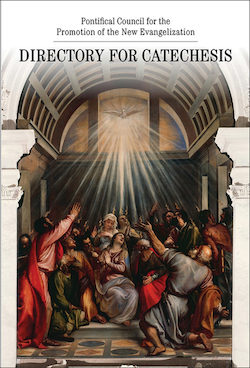 El 25 de octubre del año en curso, El Pontificio Consejo Vaticano para la Promoción de la Nueva Evangelización publicó el nuevo Directorio para la Catequesis. Este es el tercer documento apostólico explícito y oficial sobre la catequesis en tiempos recientes.
El 25 de octubre del año en curso, El Pontificio Consejo Vaticano para la Promoción de la Nueva Evangelización publicó el nuevo Directorio para la Catequesis. Este es el tercer documento apostólico explícito y oficial sobre la catequesis en tiempos recientes.
Perspectives on the New Directory for Catechesis – Encouragement for Content: Openness to the Signs of the Times
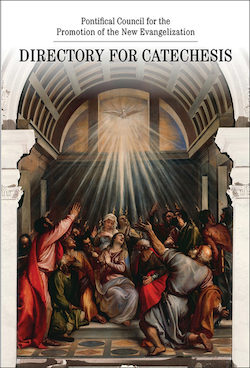 On June 25th of the current year, the Vatican’s Pontifical Council for the Promotion of the New Evangelization released the new Directory for Catechesis. This is the third explicit apos- tolic and official document on catechesis in recent times.
On June 25th of the current year, the Vatican’s Pontifical Council for the Promotion of the New Evangelization released the new Directory for Catechesis. This is the third explicit apos- tolic and official document on catechesis in recent times.
AD: New Online Undergraduate Degrees in Theology and Philosophy from Franciscan!
Youth & Young Adult Ministry: Ten Criteria to Evaluate a Youth Program
Do you want to know the most common questions a youth minister gets asked? “How many kids came to youth group last night?” or “How many kids signed up for the retreat?” Throughout my 10+ years of working as a parish youth minister, I can’t tell you how many times I’ve been asked these questions as a way to evaluate the success of the parish youth program. Now, typically a youth minister responds to the most popular question with the most popular answer, which is “Youth ministry isn’t about numbers; if we change one heart it’s worth it.”
Unfortunately, “nickels and noses” (money and numbers), as Gil Rendle puts it in his book Doing the Math of Mission, are two of the quickest and simplest ways to evaluate ministry. Rendle, however, makes the distinction between counting and measuring, saying that counting is “more about resources and activities than about outcomes,” whereas measuring is about “change… it is more about call, purpose, and possibility.”[1] Whether clearly articulated or not, I don’t think anyone would argue that “change” is what ministry is all about. Conversion, growth, holiness: these are about change, not numbers. Isn’t this what we want to see happening in the lives of our teens?
As our culture degenerates into a post-Christian, secular humanist society, youth ministry becomes more difficult. Some studies show that Gen Z is the “least religious” generation in our country today. Youth ministers have to work harder and be more creative than ever before to connect to students. Students are busier than ever. No longer are Wednesday nights and Sundays reserved for “families and faith”; school and club teams schedule events during these previously hallowed times. Because students are more connected through social media and the internet, why go to youth group when they can watch a well-edited YouTube video or do a simple Google search to find their answers about God?


